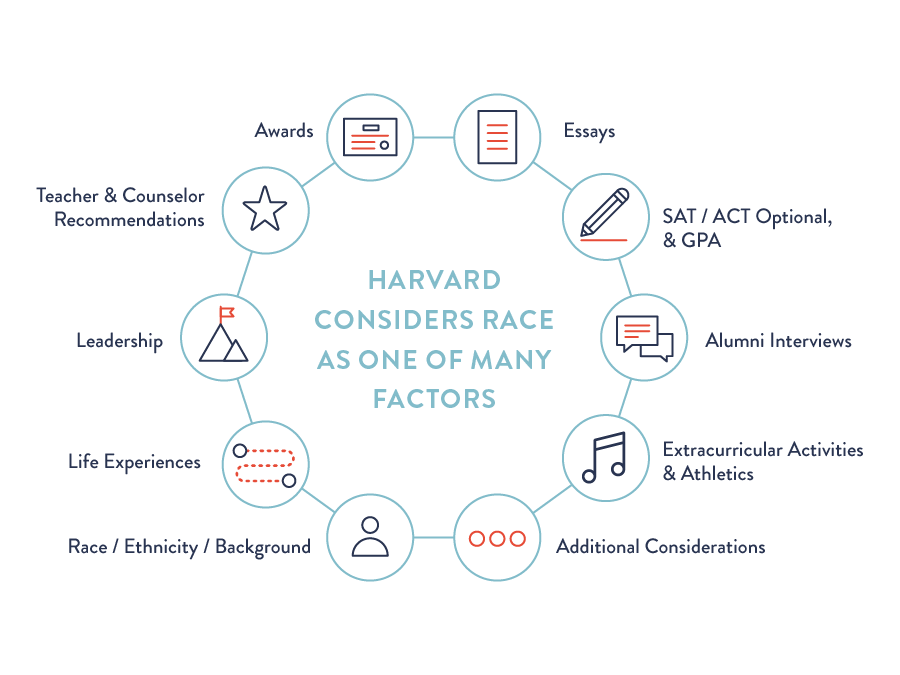The Lawsuit
The Case
A threat to educational opportunity for millions of young people.

About the case
A politically motivated lawsuit brought by Edward Blum and the organization he created, Students for Fair Admissions (SFFA), wants to remove the consideration of race in college and university admissions.
In November 2014, an organization created by anti-race conscious admissions activist Edward Blum calling itself Students for Fair Admissions (SFFA) sued Harvard, alleging that the University discriminates against Asian-Americans and seeking to prevent Harvard College and other colleges and universities from using a wide-ranging and thorough admissions process that considers the whole person.
The following spring, in a parallel effort, a group of individuals also lodged a complaint against Harvard with the Department of Education and the Department of Justice. The Department of Education evaluated and dismissed the complaint during the summer of 2015. In late 2017, under the Trump administration, the Department of Justice reopened the investigation. The Department of Education complaint remains closed.
These actions are the continuation of a series of challenges to the consideration of race in admissions in higher education orchestrated by Mr. Blum. In 2008, some of the same individuals launched a similar lawsuit against the University of Texas at Austin. The Supreme Court upheld UT’s admissions policies in 2016, reaffirming the value of creating a diverse student body and allowing university officials to consider the whole person, including each person’s individual background and life experiences, when making admission decisions among academically qualified applicants.
Frequently asked questions
If the case against Harvard succeeds, it would diminish students’ opportunities to live and learn in a diverse campus environment—denying them the kind of experiences that are central to Harvard’s educational mission and critical for success in our diverse society.
Harvard College does not discriminate against applicants from any group in its admissions processes. We will continue to vigorously defend the right of Harvard, and other colleges and universities, to seek the educational benefits that come from a class that is diverse on multiple dimensions, from its capacity for academic excellence to its ability to help create a campus community that gives each student the opportunity to learn from peers with a wide variety of academic interests, perspectives, and talents.
Admissions Process
Harvard seeks to assemble an extraordinary and diverse class of undergraduate students by conducting a wide-ranging review of every aspect of each applicant’s background and experience. Our admissions process values academic excellence, but never reduces applicants to any one factor, such as grades or test scores. Decisions to admit an applicant are made by the full, diverse, 40-person admissions committee through which each member has one vote.
Whole person review
The College treats each applicant as an individual, and holds an expansive view of excellence; the admissions committee looks at the whole person and considers each applicant’s unique background and experiences, alongside grades and test scores, to find applicants of exceptional ability and character, who can help create a campus community that is diverse on multiple dimensions (including on academic and extracurricular interests, race, socioeconomic background, and life experiences), and who can take advantage of all that Harvard offers and contribute to the learning and social environment for their classmates. Factors such as life experiences, overcoming adversity, or specific talents are particularly important in deciding who will be offered admission.
Race is one of many factors that Harvard considers in evaluating each applicant as a whole person, an approach that helps create a diverse campus community where students from all walks of life have the opportunity to share ideas and learn from each other. Harvard also uses many race-neutral means to pursue diversity—including extensive recruiting and one of the most generous financial aid policies in the country—and it has carefully studied other potential race-neutral measures, ultimately concluding that the consideration of race, among many other factors, remains necessary to attain an exceptional class that is diverse on many dimensions and central to the ability of Harvard College to pursue its educational mission.

Key statistics
Applicant academic qualifications A large percentage of applicants are academically qualified to be admitted to Harvard. For example, each year, far more applicants have perfect SAT verbal scores or perfect SAT math scores than are admitted. While academic ability is important and necessary, and transcends test scores and GPAs, for applicants who are academically qualified, other factors bear significantly on admissions decisions.
An extraordinary applicant pool
The large majority of the 60,000+ applicants to Harvard College are academically qualified, requiring the College to consider more than grades and test scores.
-
In a recent admissions cycle there were:
-
2,000
available slots at Harvard College.
-
8,000
domestic applicants had perfect GPAs.
-
4,000+
applicants were ranked first in their high school classes.
-
18,000+
scored 700 or above on the SAT reading and writing test.
-
20,000+
scored 700 or above on the SAT math test.
Increase in applicants In recent years, there has been a steady increase in applicants across racial categories. Since 2010, the share of the Harvard admitted class that is Asian-American has grown significantly. The percentage of the class that is Asian-American fluctuates from year-to-year, though with overall growth. For example, the admitted class of 2016 had 16.3% more Asian-American students than the admitted class of 2015, while the admitted class of 2017 had 3.9% fewer Asian-American students than the admitted class of 2016.

Who supports Harvard’s case?
Supporters of race conscious admissions include the Asian American Legal Defense and Education Fund, the American Council on Education, the Anti-Defamation League, former military officials, faith organizations, leading economists and social scientists, and major American corporations including Apple, General Electric, Intel, Microsoft, and Verizon.
Fact Check
Harvard College’s admissions process reflects its commitment to excellence, diversity, and expanding opportunity to educate world-changing citizens and citizen leaders. The allegations from Students for Fair Admissions (SFFA), a private organization working to end the consideration of race in admissions, are dangerously misleading, distorting data to reach preconceived and wrong conclusions.
These are the facts.
Flawed use of data by SFFA produces wrong conclusions
Professor David Card, a nationally recognized economist and professor at the University of California at Berkeley, comprehensively analyzed six years of data across all domestic applicants to Harvard College, using all factors of consideration in the admissions database, and found no evidence of discrimination against Asian Americans.
Professor Card found that the average marginal effect of being Asian American on an applicant’s likelihood of admission was statistically indistinguishable from zero, and in fact was slightly positive in three of six years at issue in this case.
SFFA’s allegations of racial balancing ignore data showing that the racial composition of the admitted class meaningfully varies from year to year. SFFA’s own expert admitted that there are changes over time in the racial composition of the admitted class.
The percentage of Asian Americans in the admitted class has grown significantly by 27% since 2010; Asian Americans comprise nearly 23% of the admitted class of 2022.
SFFA misrepresents documents and the University’s treatment of documents from Harvard’s Office of Institutional Research (OIR). Some OIR employees attempted to model the admissions process, with what the documents themselves recognize was limited information and an incomplete understanding of the admissions process itself. The OIR documents explicitly state that they could not draw conclusions precisely because of the incomplete nature of the information available to OIR, a fact SFFA fails to mention.
SFFA’s descriptions of Harvard’s admissions process irresponsibly misrepresent the truth
SFFA completely misrepresents the personal rating, which reflects a wide range of applicant information, such as personal essays, recommendations from teachers and guidance counselors, and alumni interview reports. The success of prospective students is not just a function of their prior academic, extracurricular, and athletic successes; Harvard also values a broader range of other characteristics.
As Professor Card explains, there is no reliable way for a statistical model to estimate how race affects the personal rating, due to unobservable factors.
SFFA’s mischaracterizes data the admissions office periodically reviews, falsely suggesting that Harvard places too much weight on applicants’ racial or ethnic identities. In fact, these documents contain a broad snapshot of the tentatively admitted class and the prior class, noting the number of applicants by geography, intended concentration, gender, athletic recruits, legacy students, applicants for financial aid, applicants deemed socioeconomically disadvantaged based on a review of their application file, applicants who requested a waiver of their application fee, dual citizens, U.S. citizens, citizens of other countries, permanent residents, and race.
Harvard considers race in accordance with Supreme Court precedent
The unrebutted testimony of Harvard’s admissions officers—which SFFA ignores entirely—describes a process in which race is indeed a factor that can contribute to a student’s admission, but merely one factor among many, many others.
Harvard takes the same approach to race that the Supreme Court embraced in Justice Powell’s opinion in Bakke, and in Grutter, and Fisher II.
Professor Card found exactly what one would expect: applicants must have multiple areas of strength to be admitted to Harvard, and race does not determine admissions outcomes any more than a number of other factors.
Harvard’s consideration of race-neutral alternatives follows the law
For the past several decades, Harvard has engaged in race-neutral strategies to achieve the educational benefits of diversity—including several suggested by SFFA’s own expert.
Harvard devotes tremendous resources to recruitment, and since the 1970s has maintained a dedicated program aimed at the recruitment of racial and ethnic minorities, including Asian Americans.
Harvard eliminated—then reinstated—its early action program when it found that the elimination of early action was hindering efforts to achieve racial diversity.
Harvard’s world-leading financial aid program is designed to ensure that every admitted student can attend Harvard regardless of ability to pay.
If Harvard stopped taking race into consideration as one factor in its admissions process and adopted the race-neutral alternatives that SFFA suggested, the result would be a class that fails to achieve the diversity and excellence that Harvard seeks. Harvard has concluded that such a result would severely compromise its ability to achieve the educational benefits that flow from a student body that is diverse across many dimensions, including race.